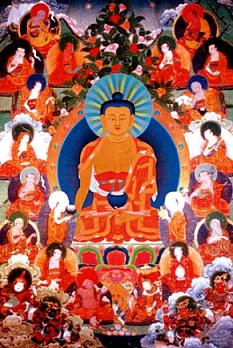Sixteen Arhats: Difference between revisions
Jump to navigation
Jump to search
No edit summary |
No edit summary |
||
| Line 1: | Line 1: | ||
[[Image:Buddha16Arhats.JPG|frame|'''Buddha and the Sixteen Arhats''']] | [[Image:Buddha16Arhats.JPG|frame|'''Buddha and the Sixteen Arhats''']] | ||
'''Sixteen Arhats''' or '''Sthaviras''' (Tib. | '''Sixteen Arhats''' or '''Sthaviras''' (Skt. Ṣoḍaśa Sthavirāḥ; Tib. Neten Chudruk; [[Wyl.]] ''gnas brtan bcu drug''). [[Buddha Shakyamuni]] personally selected the Sixteen [[Arhat]]s from amongst his disciples and requested them to remain in the world, protecting the [[Dharma]] for as long as beings are capable of benefitting from the teachings. They vowed at the time of the [[parinirvana]] to remain in the world and maintain the Dharma until the time of the future Buddha [[Maitreya]]. To visualize the [[Buddha Shakyamuni]] surrounded by the Sixteen Arhats and an assembly of [[bodhisattva]]s generates great [[merit]] and quickly develops insight into the teachings of the Buddha. | ||
#[[Angaja]] (Tib. Yenlag Chung; Wyl. ''yan lag ‘byung'')<br> | #[[Angaja]] (Tib. Yenlag Chung; Wyl. ''yan lag ‘byung'')<br> | ||
#[[Ajita]] (Tib. Ma Phampa; Wyl. ''ma pham pa'')<br> | #[[Ajita]] (Tib. Ma Phampa; Wyl. ''ma pham pa'')<br> | ||
#[[ | #[[Vanavasin]] (Tib. Nagna Né; Wyl. ''nags gnas'')<br> | ||
#[[ | #[[Mahakalika]] (Tib. Düden Chenpo; Wyl. ''dus ldan chen po'')<br> | ||
#[[ | #[[Vajriputra]] (Tib. Dorje Möbu; Wyl. ''rdo rje mo’i bu'')<br> | ||
#[[ | #[[Shribhadra]] (Tib. Pal Zangpo; Wyl. ''dpal bzang'')<br> | ||
#[[Kanakavatsa]] (Tib. Sergyi Be'u; Wyl. ''gser gyi be’u'')<br> | #[[Kanakavatsa]] (Tib. Sergyi Be'u; Wyl. ''gser gyi be’u'')<br> | ||
#[[Kanaka]] (Tib. Serchen; Wyl. ''gser can'')<br> | #[[Kanaka]] (Tib. Serchen; Wyl. ''gser can'')<br> | ||
#[[Bakula]] (Tib. Bakula; Wyl. ''bakkula'')<br> | #[[Bakula]] (Tib. Bakula; Wyl. ''bakkula'')<br> | ||
#[[Rahula | #[[Rahula]], the Buddha's son (Tib. Drachen Dzin; Wyl. ''sgra gcan 'dzin'')<br> | ||
#[[Chulapanthaka]] (Tib. Lamtren Ten; Wyl. ''lam phran bstan'')<br> | #[[Chulapanthaka]] (Tib. Lamtren Ten; Wyl. ''lam phran bstan'')<br> | ||
#[[ | #[[Pindola Bharadvaja]] (Tib. Dza Sönyom Len; Wyl. ''bha ra dva ja so nyom len'')<br> | ||
#[[Panthaka]] (Tib. Lamten; Wyl. ''lam chen bstan'')<br> | #[[Panthaka]] (Tib. Lamten; Wyl. ''lam chen bstan'')<br> | ||
#[[ | #[[Nagasena]] (Tib. Lü Dé; Wyl. ''klu sde'')<br> | ||
#[[Gopaka]] (Tib. Bé Chépa; Wyl. ''sbed byed'')<br> | #[[Gopaka]] (Tib. Bé Chépa; Wyl. ''sbed byed'')<br> | ||
#[[Abhedya]] (Tib. Michépa; Wyl. ''mi phyed pa'')<br> | #[[Abhedya]] (Tib. Michépa; Wyl. ''mi phyed pa'')<br> | ||
Revision as of 18:22, 30 August 2008

Sixteen Arhats or Sthaviras (Skt. Ṣoḍaśa Sthavirāḥ; Tib. Neten Chudruk; Wyl. gnas brtan bcu drug). Buddha Shakyamuni personally selected the Sixteen Arhats from amongst his disciples and requested them to remain in the world, protecting the Dharma for as long as beings are capable of benefitting from the teachings. They vowed at the time of the parinirvana to remain in the world and maintain the Dharma until the time of the future Buddha Maitreya. To visualize the Buddha Shakyamuni surrounded by the Sixteen Arhats and an assembly of bodhisattvas generates great merit and quickly develops insight into the teachings of the Buddha.
- Angaja (Tib. Yenlag Chung; Wyl. yan lag ‘byung)
- Ajita (Tib. Ma Phampa; Wyl. ma pham pa)
- Vanavasin (Tib. Nagna Né; Wyl. nags gnas)
- Mahakalika (Tib. Düden Chenpo; Wyl. dus ldan chen po)
- Vajriputra (Tib. Dorje Möbu; Wyl. rdo rje mo’i bu)
- Shribhadra (Tib. Pal Zangpo; Wyl. dpal bzang)
- Kanakavatsa (Tib. Sergyi Be'u; Wyl. gser gyi be’u)
- Kanaka (Tib. Serchen; Wyl. gser can)
- Bakula (Tib. Bakula; Wyl. bakkula)
- Rahula, the Buddha's son (Tib. Drachen Dzin; Wyl. sgra gcan 'dzin)
- Chulapanthaka (Tib. Lamtren Ten; Wyl. lam phran bstan)
- Pindola Bharadvaja (Tib. Dza Sönyom Len; Wyl. bha ra dva ja so nyom len)
- Panthaka (Tib. Lamten; Wyl. lam chen bstan)
- Nagasena (Tib. Lü Dé; Wyl. klu sde)
- Gopaka (Tib. Bé Chépa; Wyl. sbed byed)
- Abhedya (Tib. Michépa; Wyl. mi phyed pa)
Further Reading
In Tibetan
- Mipham Rinpoche, 'phags pa'i gnas brtan chen po bcu drug gi lo rgyus mdor bsdus
In English
- Crystal Mirror, volume VI, Dharma Publishing 1984
- M. W. de Visser, The Arhats in China and Japan, Oesterheld & Co. Berlin, 1923
- Tate, J. 'The Sixteen Arhats in Tibetan Painting,' in Oriental Art 35, 4 1989/90, pp. 196-206